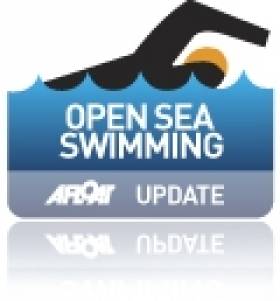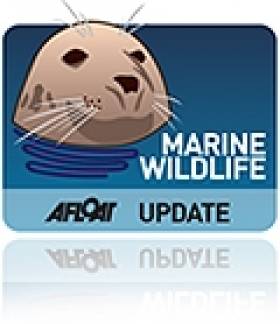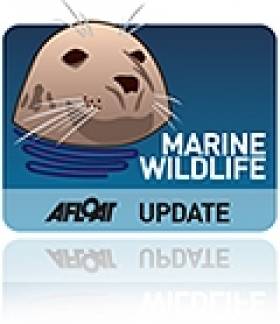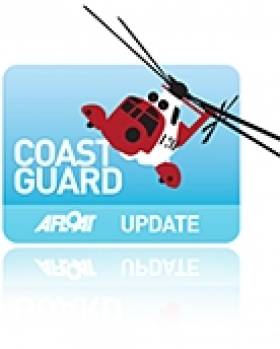Displaying items by tag: Cumbria
#coastguard – A massive search is underway for a missing swimmer in the Ravenglass estuary.
Liverpool Coastguard took a 999 call from a member of the public just after 9am this morning. They reported seeing a man up to his chest in the water and then attempt to swim across the estuary. He soon disappeared from view but his dog made it back to shore and was barking for his owner.
The Millom and Whitehaven Coastguard Rescue Teams, the search and rescue helicopter from RAF Valley, the St Bees RNLI inshore lifeboat, the Haverigg inshore rescue boat, along with Cumbria Fire and Rescue, Cumbria Police and North West Ambulance Service have been sent to the scene.
Paul Parkes, Watch Manager at Liverpool Coastguard, said:
"We are currently coordinating a large-scale search and doing all we can to find this missing man.
"If anyone was in the area earlier this morning and has information on this swimmer, please call Liverpool Coastguard on 01519 313341
Courtmacsherry RNLI Volunteer Assists Call-Out Off English Coast
#RNLI - A volunteer crew member from Courtmacsherry RNLI found himself involved in a lifeboat call out miles from home this week when he went to the assistance of yacht involved in a collision off Cumbria yesterday (29 August).
Barrow RNLI launched their all-weather lifeboat when Liverpool Coastguard requested assistance following a report of a collision between a 28ft yacht, Shola, and a large vessel some 13 miles off Walney Island in Morecambe Bay.
Also making his way to the scene was Kevin Young, skipper of the Windcat 6 with two crew, who was 3.5 miles from the incident when the call for assistance was received.
It was unknown if there was any damage caused to either vessel, but the yacht skipper - a lone sailor - was believed to be suffering from shock.
Once on scene, Young transferred one of his crew aboard the casualty yacht to take command and took off the yachtsman, who was showing signs of shock. They then made their way at speed to Barrow-in-Furness where they met the Barrow lifeboat, which then took over the casualty care.
Liverpool Coastguard had also requested the attendance of a rescue helicopter from RAF Valley, and upon its arrival the casualty was airlifted from the lifeboat onto the aircraft and transferred to Furness General Hospital for assessment.
An RNLI crew member from Barrow was then put aboard the yacht with the crewman from Windcat 6 and the vessel was sailed to Roa Island, where it was assisted to moor up on a casualty mooring by the inshore lifeboat.
"The last thing I thought I would be doing at my day job would be getting involved in a call-out with the RNLI but that’s exactly what happened," said Young, who works with wind farms off the English coast but serves as a member of the volunteer lifeboat crew when home in Courtmacsherry.
"When I spoke to the lifeboat crew they seemed surprised that I was able to brief them exactly on what we had done and how we had everything ready to hand over to them, so I explained to them that I was a deputy coxswain back home on our all-weather Trent class lifeboat and they understood.
"This callout shows that you never forget your training and the desire to help those in trouble on the sea," he added. "The skipper of the yacht was clearly in shock and needed assistance and thankfully with all the agencies working together we were able to get him medical attention and transferred to hospital quickly and safely.
"It’s good to know that RNLI lifeboat volunteers are the same wherever you go."
Conference Calls On UK Govt to 'Save Our Irish Sea'
#MARINE WILDLIFE - Marine experts are calling on the UK public to pile pressure on their government to create Marine Conservation Zones (MCZs) to help protect and restore marine wildlife in the Irish Sea and around the British coast.
The Living Seas North West Conference in Cumbria recently was a call to arms for marine experts and the public to join forces to protect the oceans.
And organisers the North West Wildlife Trusts used the event to press support for nature reserves in the Irish Sea as part of a UK-wide campaign by The Wildlife Trusts for 127 MCZs around the United Kingdom.
Callum Roberts, Professor of Marine Conservation at the University of York, described areas off the Isle of Man which have never been dredged as “carpeted with life”.
He said: “In the 19th century the Irish Sea bed was crusted with oysters. Today it is not just a sea different in the quantity of the wildlife it is different in the quality of the habitats in which that wildlife lives.”
Prof Roberts described how a study showed that dredging to catch 28,000 prawns also caught 12,000 other fish, most of which were thrown away. He also spoke of dives where he has seen the seabed damaged in huge areas by trawling.
“Over-fishing is not the only thing going on in the oceans," he said, "they are also affected by climate change and pollution. Our seas are changing faster than at any other time in human history.”
Prof Roberts said he was not against fishing, but that conservationists and the fishing industry need to find some common ground. “The prosperity of wildlife and the fishing industry depend on it," he said.
Meanwhile, The Wildlife Trusts marine protected areas manager Richard White spoke about the problems caused "by all the things that human activity is doing wrong".
He added: "We are trying to increase the resilience of our marine wildlife. The critical part is that we are doing this by trying to create Marine Conservation Zones.”
Pollution was highlighted by TV star and diver Paul Rose and Caroline Salthouse of the North West Coastal Forum.
“A huge problem is ocean debris," said Rose. "In 43 years of diving I am beginning to see more plastic and less fish. It is an issue that we must use to get people engaged in what is going on in our seas.”
Salthouse called for the public not only to sign the Wildlife Trusts’ new 'Petition Fish', but also to write to the British government as individuals.
More details about the Marine Conservation Zones and Petition Fish can be found at www.wildlifetrusts.org/living-seas
Graduates to Learn About Marine Conservation in the Irish Sea
#MARINE WILDLIFE - The News & Star reports that four graduate students have joined an 11-month scheme run by the Cumbria Wildlife Trust to learn more about marine conservation in the Irish Sea.
The programme, which includes classes and on-the-job training, will see them work at the South Walney Nature Reserve near Barrow-in-Furness, which is designatied as a Site of Specific Scientific Intrest, a Special Area of Conservation and a Special Protection Area.
“The graduates will play a pivotal role in helping people to understand and value the wildlife that exists in the Irish Sea and what role they can play in both protecting and enjoying it," said programme manager Emily Baxter.
Late last year, the find of a rare leatherback turtle washed up in Cumbria was taken as a sign that the Irish Sea is hiding an unknown bounty of marine wildlife, and reinforced calls for the region to be designanted as a Marine Conservation Zone.
Cumbrians Urged to Try New Fish to Save Irish Sea Stocks
#FISHING - Seafood lovers of Cumbria in north-west England have been urged to broaden their tastes to save depleted stocks of their favourite fish in the Irish Sea.
According to the News & Star, some 80% of Britons "insist upon eating just five types of fish – cod, tuna, salmon, prawn and haddock."
But the Cumbria Wildlife Trust says that with coastal waters facing the serious threat of overfishing, a rethink is needed among both consumers and suppliers alike.
“The Irish Sea has a wide range of edible fish species but you wouldn’t know it judging by the fish counters in supermarkets across the county," says Lindsay Sullivan of the trust's Wild Oceans project, an 18-month scheme that hopes to "turn the tide for seafood".
A big part of this is encouraging consumers to skip the usual white fish and try different species such as flounder, monkfish and red mulllet, creating demand for cheaper and more sustainable fishing.
The News & Star has more on the story HERE.
Leatherback Turtle Sign that Irish Sea Hides Wildlife Wonders
#MARINE WILDLIFE - A rare leatherback turtle washed up in Cumbria could be a sign that the Irish Sea is hiding an unknown bounty of marine wildlife.
The Cumbria Wildlife Trust told The Westmoreland Gazette that the find reinforces calls for the Irish Sea region to be designated as a Marine Conservation Zone.
Leatherback turtles are on the critically endangered list, and face any number of threats, from injury by boat propellors, to drowning in fishing nets below the surface.
The green waters of the Irish Sea are a big attraction to leatherback turtles and species from the Caribbean and other far-away climbs due to their abundance of food.
The Westmoreland Gazette has more on the story HERE.
Two Fishermen Rescued After an Hour in the Water
Liverpool Coastguard received a 999 call from a member of the public at just after 1.30pm. The caller had heard calls for help from the water and spotted two people in difficulty off Silloth, Cumbria. Coastguard Rescue Teams from Maryport and Burgh by Sand were sent to the scene with the RNLI Inshore Lifeboat from Silloth and Maryport Inshore Rescue Boat.
The fishermen were rescued from the water by the RNLI Inshore Lifeboat and taken to hospital in Carlisle by ambulance. It then transpired that they had been fishing for shrimps at Cardurnock Flats, four miles from where they were found. It appears that their net got caught and their ten-metre fishing vessel 'Boy Bailey' turned over in the water. The vessel then sank and the men spent an hour drifting in the water, supported by life rings.
Tony Topping Liverpool Coastguard Watch Manager said:
"These fishermen were extremely lucky. Firstly they managed to grab life rings and then the tide carried them the four miles down to Silloth.
"The MCA recommends that commercial fishermen wear a personal floatation device or lifeline whilst working on the deck of a vessel at sea. This will keep you afloat should the unexpected happen and if you also have your vessel fitted with VHF DSC radio equipment which can send a distress alert you'll also have a way of calling for assistance when you need it."
Single Handed Yachtsman Caught in Gale Calls for Assistance
The yacht owner had been seeking permission to come into the harbour seeking a safe haven as the weather conditions had begun to deteriorate, and the Coastguard were alerted by the harbour authorities. The harbour authorities expressed concern at the time about the condition of the vessel, a 22 foot, single masted, single person crewed vessel with a blue hull. The weather forecast was suggesting westerly winds of 21 to 29 knots at St Bees Head.
However by 5.40 am the yacht still endeavouring to keep out of the weather and he reported to the harbour authorities that he had taken a lot of water into his vessel. He was reassured by the authority that the Coastguard had been informed and the Whitehaven Coastguard Rescue Team were turned out. The Workington RNLI all weather lifeboat were also requested to launch.
By now the wind was gusting 42 knots and had turned to the north west which meant it was blowing straight into the harbour and causing the skipper major problems as the vessel was being thrown against the pier in the outer harbour. He was trapped in his cabin.
The Cumbria Coastguard Sector Manager was also alerted, and an ambulance called.
By 6.30 this morning the RNLI all weather boat had arrived and deploying their small 'Y' boat they sent two crew members across to the 'Tern' to get the skipper out from the badly flooded yacht. In the confined activities, one Coastguard Team Member was hit by the flailing mast and was taken to hospital. The skipper of the yacht was also taken to hospital suffering from hypothermia.
Paul Campbell, Watch Manager at Liverpool Coastguard said
"This was quite an awkward job in very difficult and deteriorating weather conditions. Fortunately the skipper is now safely in hospital and our own Coastguard Rescue Officer was given a check by the A&E department and discharged."
Proposed Irish Sea Conservation Zones
The area include the inshore waters of Merseyside, Lancashire and Cumbria and offshore waters of the Isle of Man, Wales, Northern Ireland and England. One of the zones is a 187 square km stretch of deep water between Northern Ireland and the Isle of Man.
In order to gain a greater understanding of the proposed zones, the report commissioned a Regional Stakeholder Group which drew from a diverse range of interests in the Irish Sea. Among the stakeholders included were the Royal Yachting Association, the fishing community and ports authorities. The review identified the size, shape and locations of the proposed 10 ten new Marine Conservation Zones. For the first time, the zones included inshore water of the Irish Sea project area as well as offshore.
"This is a real milestone for the project, with potential Marine Conservation Zones identified in both inshore and offshore waters", said Greg Whitfield, project manager at Irish Sea Conservation Zones.
"It is now really important that people take a look at the potential zones and give us their feedback on them. The better the information we have, the better the Marine Conservation Zones that are recommended by the regional stakeholder group will be."
Each of the marine conservation zones are designed to protect nationally important marine wildlife, habitats and geology. In addition they are designed to have the least impact possible on people's activities, but some restrictions will apply as the zones must meet guidelines for protecting species and habitats.
Members of the public are being invited to participate and will be considered as the second project continues to refine its proposals. The report is only a snapshot of the work so far. It does not contain concrete recommendations for the locations of Marine Conservation Zones (MCZ) in the Irish Sea, and the potential zones shown in the report are described as tentative and liable to change.
The Irish Sea Conservation Zone project will be releasing a third report before the Regional Stakeholder Group finalises its recommendations. The reports are delivered to the Science Advisory Panel. The independent body is comprised of expert scientists whose main role is to evaluate the potential of MCZs against ecological criteria.
The third progress report will be made available in February 2011. Its final recommendations will then be presented to the UK government in June. Following that a formal public consultation on the proposed MCZs are to take place in late 2011 and early 2012.
For information on the Second Progress Report including feedback forms can be downloaded from HERE or by calling 00 44 (0)1925 813 200




































































